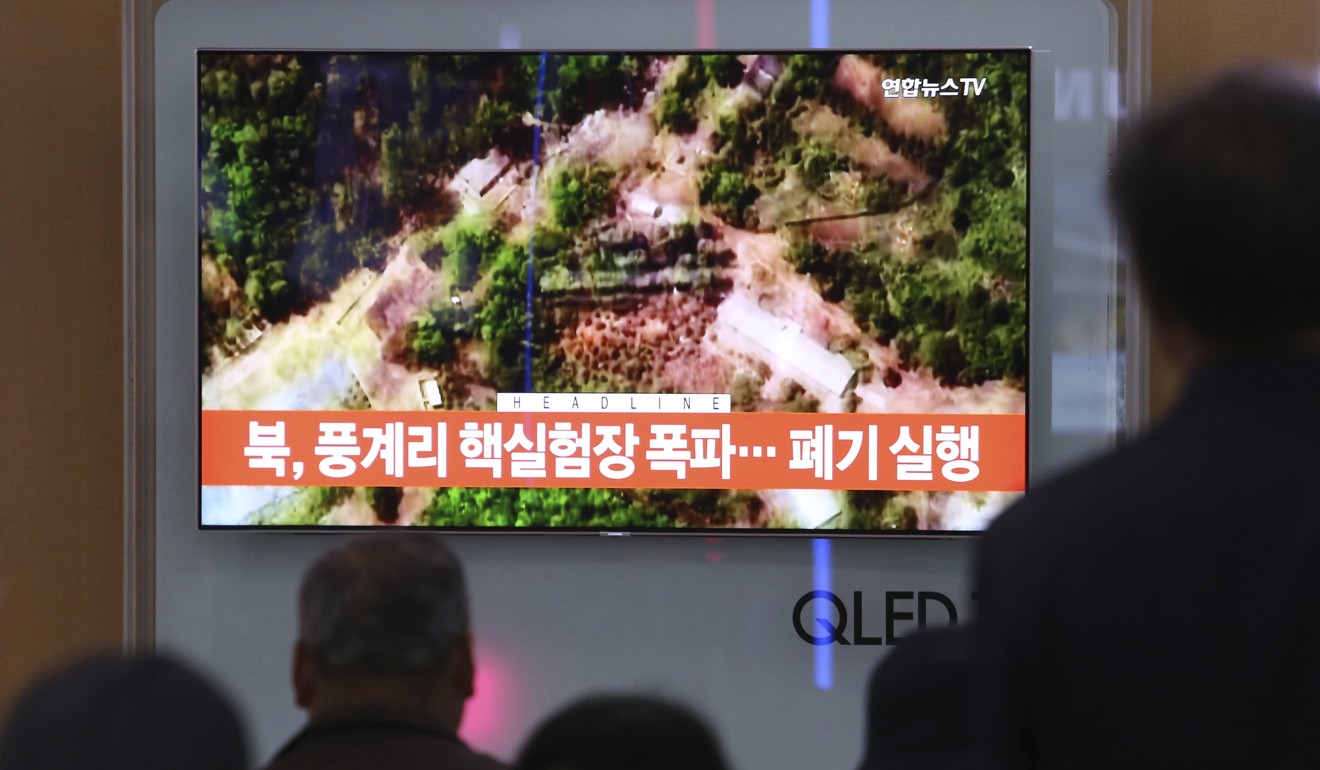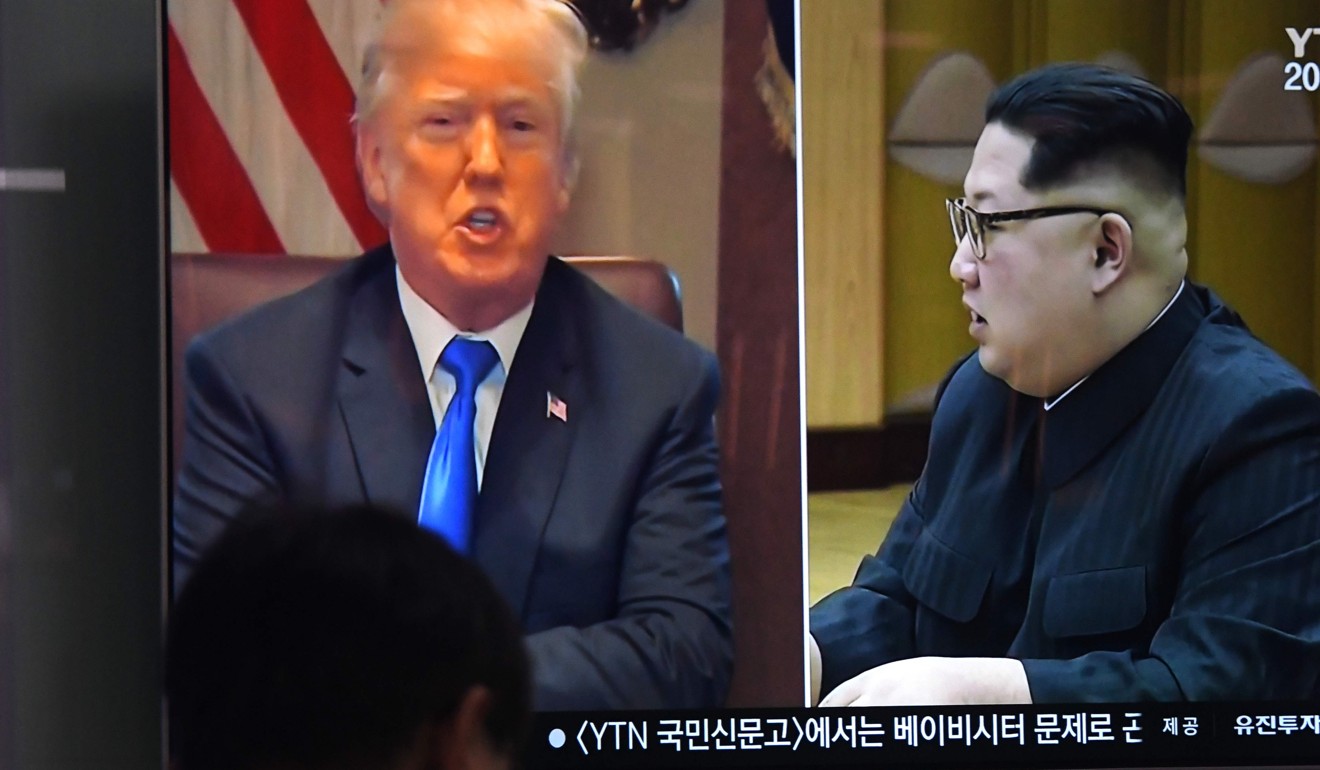
North Korea says it has completely destroyed nuclear test site
Reporters at the scene describe powerful explosions at remote Punggye-ri facility as state news says move will ensure ‘transparency’ in disarmament process
North Korea said on Thursday that it had completely dismantled its Punggye-ri nuclear test ground.
The explosions deep in the mountains of the hermit state’s sparsely populated northeast were conducted in the presence of foreign journalists and centred on three tunnels leading into the underground site and a number of observation towers in the surrounding area.
State news agency KCNA said the process would “ensure the transparency of discontinuance of nuclear tests”.
Trump calls off Kim Jong-un meeting and boasts of ‘massive’ US nukes
The planned demolition had been announced by North Korean leader Kim Jong-un ahead of his planned summit with US President Donald Trump next month.
Punggye-ri has been the staging ground for all six of the North’s nuclear tests, including its latest and most powerful one in September last year, which Pyongyang said was an H-bomb.
South Korean reporters on Wednesday joined a small group of Chinese and other foreign media outlets covering the event.
But Lee Chun-geun, a senior research fellow at the Science and Technology Policy Institute in Sejong, South Korea, said before the demolition that the North must blow up the whole site rather than merely shutting it down to prove its commitment to getting rid of its nuclear weapons.
“If only the entrance is blown up, it would be classified as a closure and the site may be used again later if Pyongyang decides to proceed with additional nuclear tests,” Lee said.
The site must be packed internally with explosives and all tunnels destroyed to ensure the facility cannot be reopened, he said.
There are four tunnels at the site, two of which are unused. The eastern tunnel was used for the first nuclear test in 2006, but was abandoned due to contamination.
The northern tunnel was used for five subsequent tests. The newly built western and southern tunnels remain unused.
“If the explosions are inside – especially in the unused western and southern tunnels – you can then call this a dismantlement as North Korea won’t be able to reuse the venue again even if they change their minds in future,” Lee added.
Yonhap news agency, citing South Korean pool reporters at the scene, said multiple explosions were heard throughout the day, beginning at 11am (3am GMT) until 4.17pm.
A South Korean reporter who had been invited to the site described the scene as reporters and soldiers gathered ahead of the blast.
“Just before 11am someone asked ‘Are you ready to shoot?’ and the reporters said that they were ‘ready for filming’. They counted ‘3 2 1’ and there was an explosion,” the reporter said.
“Fifteen seconds later, the station was demolished. Deep smoke accompanied the roar, and the smoke covered the valley. As the smoke broke, fragments from the observatory crashed all over the place.”
The North’s decision to close the Punggye-ri nuclear test site has generally been seen as a welcome gesture by Kim to set a positive tone ahead of his summit with Trump.
Even so, it would need to be followed by many more significant measures to meet Trump’s demands for real denuclearisation.
The prospect of a successful summit between Kim and Trump has been thrown into doubt in recent days as both Washington and Pyongyang traded verbals barbs and raised the threat of cancelling the talks.
The North has called US Vice-President Mike Pence a “political dummy” and said it was just as ready to meet in a nuclear confrontation as at the negotiating table.
Pyongyang was responding to Pence’s comments in a Fox News interview, in which he said North Korea could end up like Libya without a deal.
Libya’s long-term dictator, Muammar Gaddafi, agreed to end his chemical and nuclear weapons programmes in 2003 but was overthrown and killed in a Western-backed uprising following the Arab Spring in 2011.

Apart from the possible detente with the US, North Korea has also been moving to improve its sometimes frosty relationship with China this year, with Kim paying two visits this year as the country seeks economic opportunities with its giant neighbour.
On Thursday it emerged that a North Korean delegation had made an 11-day visit to China. The South’s Yonhap agency reported that the so-called Friendship Visiting Group from the Worker’s Party had visited the northwestern province of Shaanxi, Shanghai and the eastern port of Ningbo in the company of Wang Yajun, from the international liaison department of the Chinese Communist Party.
The Ningbo Daily reported on the visit to the city on Wednesday, saying that Pak Thae-Song, who led the North Korean delegation, told the local deputy party chief Zheng Zhajie that he hoped to “learn more about China’s experiences … to push forward new and bigger achievements for North Korea’s economic development”.

Ningbo made international headlines in 2016 when 12 North Korean waitresses at the state-run Azalea Friendship Restaurant in the city defected to the South, where they sought asylum.
But the case came under media spotlight again in recent weeks after the manager of the restaurant claimed that he had lied to the women and blackmailed them into following him on the orders of the South’s spy agency. The North is now demanding their return.
Meanwhile, the Japanese news agency Kyodo reported that a high-level North Korean official had arrived in Beijing on Thursday.
The official, whose identity was not immediately clear, was picked up by a Chinese government vehicle, Kyodo said.
He could hold talks with Chinese officials before heading to Singapore, a source told Kyodo.
Additional reporting by Associated Press and Agence France-Presse


